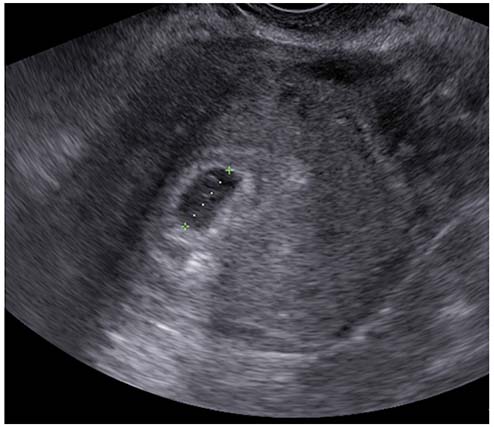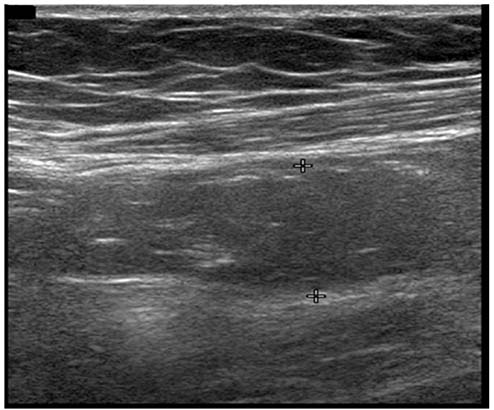Obstet Gynecol Sci.
2016 Jul;59(4):316-318. 10.5468/ogs.2016.59.4.316.
Heterotopic pregnancy after a single embryo transfer
- Affiliations
-
- 1Department of Obstetrics and Gynecology, Kyungpook National University Hospital, Kyungpook National University School of Medicine, Daegu, Korea. wjseong@knu.ac.kr
- 2Department of Obstetrics and Gynecology, Konyang University Hospital, Konyang University School of Medicine, Daejeon, Korea.
- 3Maria Fertility Clinic, Daegu, Korea.
- KMID: 2329054
- DOI: http://doi.org/10.5468/ogs.2016.59.4.316
Abstract
- Heterotopic pregnancy is a rare and life-threatening condition which is defined as coexistent intrauterine and ectopic gestation. The risk of ectopic and heterotopic pregnancy is increasing due to the increased risk of multiple pregnancies with the aid of assisted reproductive technologies. However, it hardly happens in the setting of single embryo transfer, since single embryo transfer significantly reduces the incidence of multiple pregnancies. Surprisingly, we experienced a case of heterotopic pregnancy after a single embryo transfer caused by coincidental natural pregnancy during assisted reproductive technologies. An infertile woman who underwent, during her natural cycle, transfer of a single embryo that had been cryopreserved for 3 years was found to be heterotopically pregnant. After an early and successful management with laparoscopic right salpingectomy, she finally reached at full-term vaginal delivery.
MeSH Terms
Figure
Reference
-
1. Reece EA, Petrie RH, Sirmans MF, Finster M, Todd WD. Combined intrauterine and extrauterine gestations: a review. Am J Obstet Gynecol. 1983; 146:323–330.2. Donadio NF, Donadio N, Martins PT, Cambiaghi Cde G. Heterotopic gestation: diagnostic possibility after in vitro fertilization: a case report. Rev Bras Ginecol Obstet. 2008; 30:466–469.3. Maruotti GM, Sarno L, Morlando M, Sirico A, Martinelli P, Russo T. Heterotopic pregnancy: it is really a rare event? The importance to exclude it not only after in vitro fertilization but also in case of spontaneous conception. Fertil Steril. 2010; 94:e49.4. Prevention of twin pregnancies after IVF/ICSI by single embryo transfer. ESHRE Campus Course Report. Hum Reprod. 2001; 16:790–800.5. Takehara I, Takahashi T, Hara S, Matsuo K, Igarashi H, Kurachi H. Dizygotic twin pregnancy after single embryo transfer: a case report and review of the literature. J Assist Reprod Genet. 2014; 31:443–446.6. Osianlis T, Rombauts L, Gabbe M, Motteram C, Vollenhoven V. Incidence and zygosity of twin births following transfers using a single fresh or frozen embryo. Hum Reprod. 2014; 29:1438–1443.7. Dal Prato L, Borini A, Cattoli M, Bonu MA, Sciajno R, Flamigni C. Endometrial preparation for frozen-thawed embryo transfer with or without pretreatment with gonadotropin-releasing hormone agonist. Fertil Steril. 2002; 77:956–960.8. Tremellen KP, Valbuena D, Landeras J, Ballesteros A, Martinez J, Mendoza S, et al. The effect of intercourse on pregnancy rates during assisted human reproduction. Hum Reprod. 2000; 15:2653–2658.9. Zhang X, Barnes R, Confino E, Milad M, Puscheck E, Kazer RR. Delay of embryo transfer to day 5 results in decreased initial serum beta-human chorionic gonadotropin levels. Fertil Steril. 2003; 80:1359–1363.
- Full Text Links
- Actions
-
Cited
- CITED
-
- Close
- Share
- Similar articles
-
- A case of heterotopic pregnancy following in vitro fertilization and embryo transfer
- A case of Heterotopic Pregnancy following in vitro fertilization: transcervical evacuation with preserved intrauterine pregnancy
- A Case of Combined Interstitial and Intrauterine Pregnancy as Fifth Ectopic Pregnancies after In Vitro Fertilization and Embryo Transfer in Bilateral Salpingectomy patient
- Interstitial heterotopic pregnancy by in vitro fertilization and embryo transfer after bilateral salpingectomy
- A case of heterotopic pregnancy following in vitro fertilization and embryo transfer



